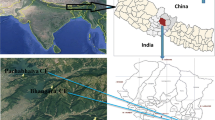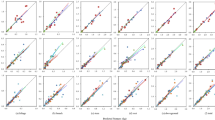Abstract
Estimating individual tree biomass is critical to forest carbon accounting and ecosystem service modeling. In this study, we developed one- (tree diameter only) and two-variable (tree diameter and height) biomass equations, biomass conversion factor (BCF) models, and an integrated simultaneous equation system (ISES) to estimate the aboveground biomass for five conifer species in China, i.e., Cunninghamia lanceolata (Lamb.) Hook., Pinus massoniana Lamb., P. yunnanensis Faranch, P. tabulaeformis Carr. and P. elliottii Engelm., based on the field measurement data of aboveground biomass and stem volumes from 1055 destructive sample trees across the country. We found that all three methods, including the one- and two-variable equations, could adequately estimate aboveground biomass with a mean prediction error less than 5%, except for Pinus yunnanensis which yielded an error of about 6%. The BCF method was slightly poorer than the biomass equation and the ISES methods. The average coefficients of determination (R 2) were 0.944, 0.938 and 0.943 and the mean prediction errors were 4.26, 4.49 and 4.29% for the biomass equation method, the BCF method and the ISES method, respectively. The ISES method was the best approach for estimating aboveground biomass, which not only had high accuracy but also could estimate stocking volumes simultaneously that was compatible with aboveground biomass. In addition, we found that it is possible to develop a species-invariant one-variable allometric model for estimating aboveground biomass of all the five coniferous species. The model had an exponent parameter of 7/3 and the intercept parameter a 0 could be estimated indirectly from stem basic density (a 0 = 0.294 ρ).


Similar content being viewed by others
References
Bentley LP, Stegen JC, Savage VM et al (2013) An empirical assessment of tree branching networks and implications for plant allometric scaling models. Ecol Lett. https://doi.org/10.1111/ele.12127
Bi H, Birk E, Turner J, Lambert M, Jurskis V (2001) Converting stem volume to biomass with additivity, bias corrections and confidence bands for two Australian tree species. NZ J For Sci 31:298–319
Bi H, Murphy S, Volkova L, Li Y, Weston C, Fairman T, Li Y, Law R, Norris J, Lei X, Caccamo G (2015) Additive biomass equations based on complete weighing of sample trees for open eucalypt forest species in southeast Australia. For Ecol Manag 349:106–121
Blujdea VNB, Pilli R, Dutca I et al (2012) Allometric biomass equations for young broadleaved trees in plantations in Romania. For Ecol Manag 264:172–184
Borders BE (1989) Systems of equations in forest stand modeling. For Sci 35(2):548–556
Brown S, Lugo EA (1984) Biomass of tropical forests: a new estimate based on forest volumes. Science 223:1290–1293
Chen CG, Zhu JF (1989) A handbook of tree biomass for main tree species in northeastern China. Chinese Forestry Press, Beijing, p 296
Fang JY (2000) Forest productivity in China and its response to global climate change. Acta Phytoecologica Sinica 24(5):513–517
Fang JY, Chen AP, Peng CH et al (2001) Changes in forest biomass carbon storage in China between 1949 and 1998. Science 292:2320–2322
Fayolle A, Doucet JL, Gillet JF et al (2013) Tree allometry in Central Africa: testing the validity of pantropical multi-species allometric equations for estimating biomass and carbon stocks. For Ecol Manag 305:29–37
Feng ZW, Wang XK, Wu G (1999) Biomass and productivity of forest ecosystems in China. Chinese Science Press, Beijing, p 241
Fu LY, Zeng WS, Tang SZ et al (2012) Using linear mixed model and dummy variable model approaches to construct compatible single-tree biomass equations at different scales: a case study for Masson pine in southern China. J For Sci 58(3):101–115
Fu LY, Zhang HR, Li CM et al (2013a) Analysis of nonlinear mixed effects model parameter estimation methods. Scientia Silvae Sinicae 49(1):114–119
Fu L, Sun H, Sharma RP, Lei Y, Zhang H, Tang S (2013b) Nonlinear mixed-effects crown width models for individual trees of Chinese fir (Cunninghamia lanceolata) in south-central China. For Ecol Manag 302:210–220
Fu L, Lei Y, Wang G, Bi H, Tang S, Song X (2016) Comparison of seemingly unrelated regressions with multivariate errors-in-variables models for developing a system of nonlinear additive biomass equations. Trees 30:839–857
Henry M, Bombelli A, Trotta C, et al. 2013. GlobAllomeTree: international platform for tree allometric equations to support volume, biomass and carbon assessment. iForest (early view): e1-e5. Available at: <http://www.sisef.it/iforest/contents/?id=ifor0901-006> [Accessed 10-02-2016]
IPCC. 2003. Good practice guidance for land use, land use change and forestry. Japan: The Institute for Global Environmental Strategies for the IPCC, 632 pp. Available at: <http://www.ipcc-nggip.iges.or.jp> [accessed 24-04-2016]
Jenkins JC, Chojnacky DC, Heath LS, Birdsey RA (2003) National-scale biomass estimators for United States tree species. For Sci 49(1):12–35
Li YC, Tang SZ (2006) Parameter estimate of the whole stand model with measurement error. J Beijing For Univ 28(1):23–27
Li CM, Zhang HR (2010) Modeling dominant height for Chinese fir plantation using a nonlinear mixed-effects modeling approach. Scientia Silvae Sinicae 46(3):89–95
Liu GH, Fu BJ, Fang JY (2000) Carbon dynamics of Chinese forests and its contribution to global carbon balance. Acta Ecol Sin 20(5):733–740
Longford NT (2001) Simulation-based diagnostics in random-coefficient models. J R Stat Soc Ser A 164:259–273
Ma QY (1989) A study on the biomass of Chinese pine forests. J Beijing For Univ 11(4):1–10
Ma QY, Xie ZM (1996) Basic estimation of carbon storage for Chinese pine forest in China. J Beijing For Univ 18(3):23–27
Muukkonen P (2007) Generalized allometric volume and biomass equations for some tree species in Europe. Eur J For Res 126:157–166
Návar J (2009) Allometric equations for tree species and carbon stocks for forests of northwestern Mexico. For Ecol Manag 257:427–434
Parresol BR (1999) Assessing tree and stand biomass: a review with examples and critical comparisons. For Sci 45(4):573–593
Sileshi GW (2014) A critical review of forest biomass estimation models, common mistakes and corrective measures. For Ecol Manag 329:237–254
Snorrason A, Einarsson SF (2006) Single-tree biomass and stem volume functions for eleven tree species ssed in Icelandic Forestry. Icel Agric Sci 19:15–24
Somogyi Z, Cienciala E, Mäkipää R et al (2007) Indirect methods of large-scale forest biomass estimation. Eur J For Res 126:197–207
State Forestry Administration (2014) Guidelines on carbon accounting and monitoring for afforestation project. Chinese Standard Press, Beijing, p 64
State Forestry Administration (2015) Technical regulation on sample collections for tree biomass modeling. Chinese Standard Press, Beijing, p 11
Tang SZ, Li Y, Wang YH (2001) Simultaneous equations, error-in-variable models, and model integration in systems ecology. Ecol Model 142:285–294
Tang SZ, Li Y, Fu LY (2015) Statistical foundation for biomathematical models, 2nd edn. Higher Education Press of China, Beijing, p 435
Ter-Mikaelian MT, Korzukhin MD (1997) Biomass equations for sixty-five north American tree species. For Ecol Manag 97:1–24
Wang M, Borders BE, Zhao D (2008) An empirical comparison of two subject-specific approaches to dominant heights modeling the dummy variable method and the mixed model method. For Ecol Manag 255:2659–2669
West GB, Brown JH, Enquist BJ (1997) A general model for the origin of allometric scaling laws in biology. Science 276(5309):122–126
West GB, Brown JH, Enquist BJ (1999) A general model for the structure and allometry of plant vascular systems. Nature 400:664–667
Woodbury PB, Smith JE, Heath LS (2007) Carbon sequestration in the US forest sector from 1990 to 2010. For Ecol Manag 241:14–27
Zeng WS (2011) Methodology on modeling single-tree biomass equations for national biomass estimation in China. Chinese Academy of Forestry, Doctoral dissertation, Beijing
Zeng WS (2014) Development of monitoring and assessment of forest biomass and carbon storage in China. For Ecosyst 1:20
Zeng WS (2015a) Using nonlinear mixed model and dummy variable model approaches to construct origin-based single tree biomass equations. Trees 29(1):275–283
Zeng WS (2015b) Integrated individual tree biomass simultaneous equations for two larch species in northeastern and northern China. Scand J For Res 30(7):594–604. https://doi.org/10.1080/02827581.2015.1046481
Zeng WS, Tang SZ (2011a) Establishment of below-ground biomass equations for larch in northeastern and Masson pine in southern China. J Beijing For Univ 33(2):1–6
Zeng WS, Tang SZ. 2011b. A new general biomass allometric model. Nature Precedings. Available at <http://dx.doi.org/10.1038/npre.2011.6704.2> [accessed 24-04-2016]
Zeng WS, Tang SZ. 2011c. Bias correction in logarithmic regression and comparison with weighted regression for nonlinear models. Nature Precedings. Available at <http://dx.doi.org/10.1038/npre.2011.6708.1> [accessed 24-04-2016]
Zeng WS, Tang SZ (2011d) Goodness evaluation and precision analysis of tree biomass equations. Scientia Silvae Sinicae 47(11):106–113
Zeng WS, Tang SZ (2012) Modeling compatible single-tree biomass equations of Masson pine (Pinus massoniana) in southern China. J For Res 23(4):593–598. https://doi.org/10.1007/s11676-012-0299-4
Zeng WS, Tang SZ, Huang GS et al (2010) Population classification and sample structure on modeling of single-tree biomass equations for national biomass estimation in China. For Resour Manag 7(3):16–23
Zeng WS, Zhang HR, Tang SZ (2011) Using the dummy variable model approach to construct compatible single-tree biomass equations at different scales—a case study for Masson pine (Pinus massoniana) in southern China. Can J For Res 41(7):1547–1554
Zianis D, Muukkonen P, Mäkipää R, Mencuccini M. 2005. Biomass and stem volume equations for tree species in Europe. Silva Fennica, (Monographs 4)
Zou WT, Zeng WS, Zhang LJ, Zeng M (2015) Modeling crown biomass for four pine species in China. Forests 6(2):433–449. https://doi.org/10.3390/f6020433
Acknowledgements
We acknowledge the National Biomass Modeling Program in Continuous Forest Inventory (NBMP-CFI) which was funded by the State Forestry Administration of China, for providing biomass measured data of 1055 sample trees of C. lanceolata, P. massoniana, P. yunnanensis, P. tabulaeformis and P. elliottii; and thank the reviewers and editors for their valuable comments.
Author information
Authors and Affiliations
Corresponding author
Ethics declarations
Conflict of interests
The authors declare that they have no conflict of interest.
Additional information
Project funding: This study was funded by National Natural Science Foundation of China (Grant Nos. 31270697, 31370634, 31570628); and supported by State Forestry Administration of China (Grant No. 2030208).
The online version is available at http://www.springerlink.com
Corresponding editor: Chai Ruihai
Rights and permissions
About this article
Cite this article
Zeng, W., Fu, L., Xu, M. et al. Developing individual tree-based models for estimating aboveground biomass of five key coniferous species in China. J. For. Res. 29, 1251–1261 (2018). https://doi.org/10.1007/s11676-017-0538-9
Received:
Accepted:
Published:
Issue Date:
DOI: https://doi.org/10.1007/s11676-017-0538-9




